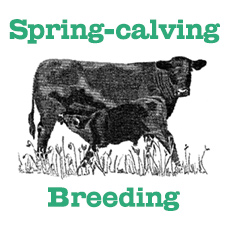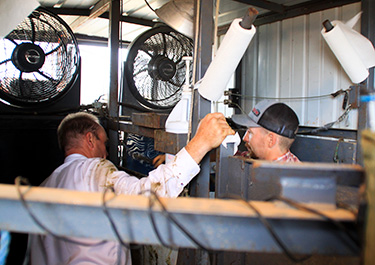AI in Beef Cattle
Advancements lead to increased profitability for commercial cattlemen.

The first known use of artificial insemination (AI) was in horses — by Arab sheiks who wanted to utilize bloodlines of tribal enemies. They’d sneak up to the other tribe’s herd at night with a mare in heat and secretly collect semen from the desired stallion into a leather pouch and take it back to their camp to inseminate a favorite mare.
Artificial insemination in U.S. cattle was first accomplished in dairy herds in the 1930s with cooled fresh semen — transported in glass vials kept cool in ice water. Most AI studs were local, because fresh semen couldn’t be transported very far. The advent of frozen semen revolutionized this process. Beef AI got started in the early 1950s.
Today the process is easier with synchronization, and conception rates have also improved. Willie Altenburg, a cattleman in northern Colorado with registered Simmental and Angus, works for Select Sires and says heat synchronization has worked very well for heifers for many years.
“We were having less success with cow synchronization, but advent of the CIDR® and use of prostaglandin really helped with that. Synchronization and fixed-time insemination has helped a lot when working with cows, but we need a team effort to get this accomplished. Most producers can’t breed 100 cows in one morning,” he says.
 |
AI is affordable, he says, and the expertise of people who come to these ranches to give a full-service program to get the job done can easily get 60% of the females pregnant on the first day. |
“AI organizations now have portable breeding barns and technicians who come do chuteside service — and get those cows all bred in a few hours,” says Altenburg.
Progress in AI techniques has been aided by the Beef Reproductive Task Force in figuring out the best AI protocols. This is a group of researchers who work with beef reproduction at various universities, doing research on estrous synchronization and AI.
“Our goal is to have six out of every 10 animals that leave the breeding shed pregnant on the first day of breeding season. This makes a difference in terms of your needed bull power,” says Altenburg.
With the cost of AI and the cost of bulls, more large herds are incorporating AI into their business plan. It is affordable, he says, and the expertise of people who come to these ranches to give a full-service program to get the job done can easily get 60% of the females pregnant on the first day. Having that many females pregnant early in the season makes the producer money.
Some of the newer reproductive technologies available today include embryo transfer and sexed semen, but the average commercial cowman isn’t going to use these tools.
“Of all the things that I’ve tried in my own operation, including embryo transfer and sorted semen, AI has made me a lot more money than anything else I’ve ever done. The more AI calves I can get, the more improvement I can get,” says Altenburg.
You can select the genetics you want for certain traits. You can breed heifers to calving-ease bulls with high growth and good maternal traits with the goal of keeping replacement heifers from that group. You can also breed the cows to a high-performance bull or terminal sire for bigger calves to sell or to make money on retained ownership through the feeding phase.
“I make more money with an $18 straw of semen than I do with anything else I do with my cows,” says Altenburg.
Some of the newer technologies may become more affordable in the future. Sexed semen at this point has a lower conception rate than regular AI (8%-10% reduction in conception), but the flip side is very good results on the gender of the resulting calves.
“If you’re breeding heifers, you can use heifer [sexed semen] to reduce dystocia (since heifer calves tend to be smaller at birth than bull calves) and then keep replacements out of your heifers, because hopefully they will be your best genetics. If you are in the bull business, you can produce males and sell $5,000 to $10,000 bulls instead of $2,000 heifers,” he says.
Editor’s note: Heather Smith Thomas is a cattlewoman and freelance writer from Salmon, Idaho. Photo courtesy Select Sires.























